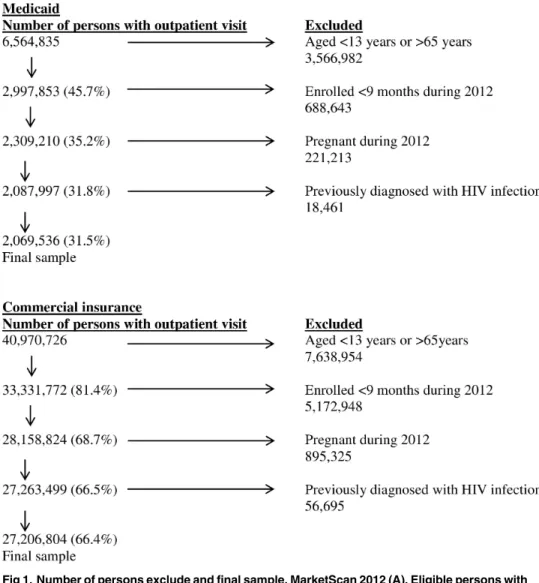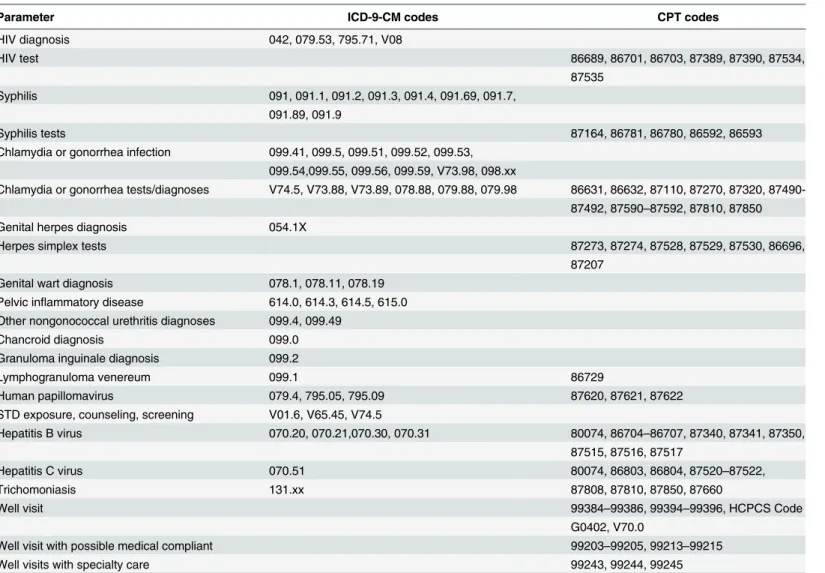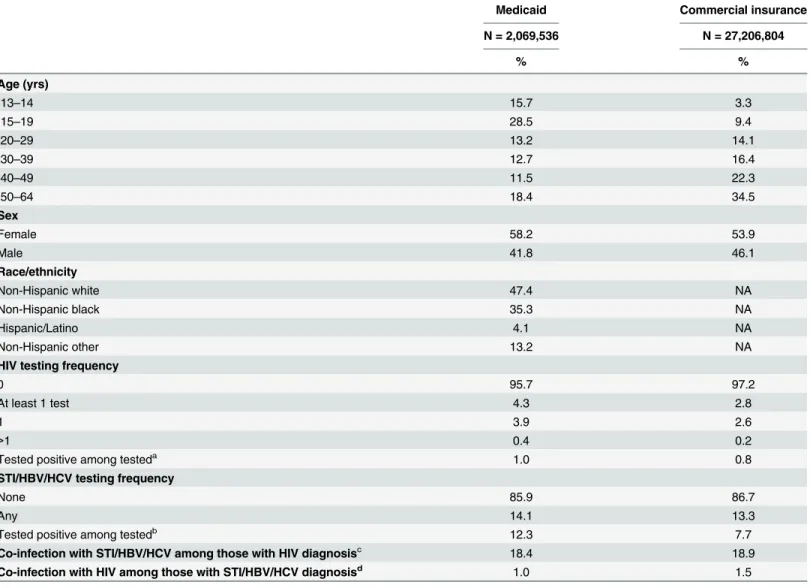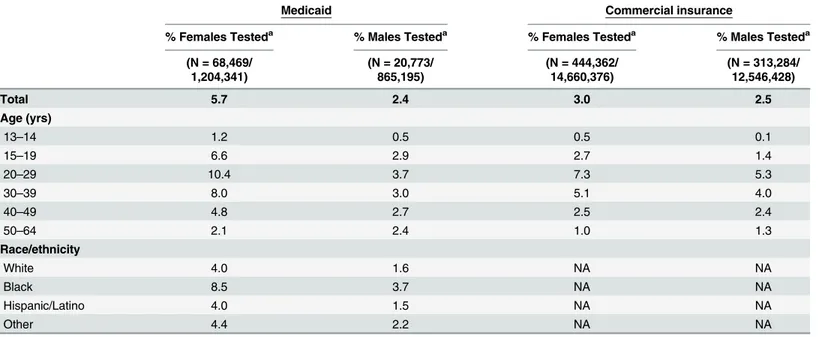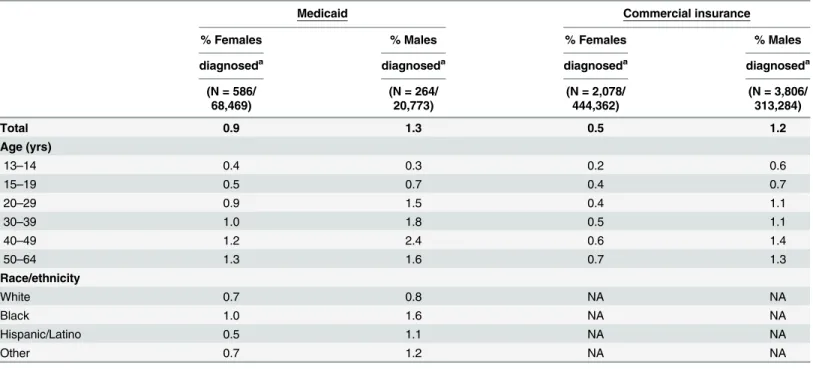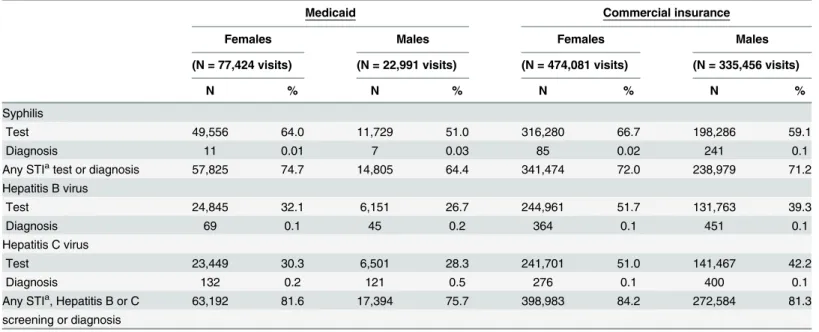HIV Testing among Outpatients with
Medicaid and Commercial Insurance
Patricia M. Dietz*, Michelle Van Handel, Huisheng Wang, Philip J. Peters, Jun Zhang, Abigail Viall, Bernard M. Branson
Division of HIV/AIDS Prevention, Centers for Disease Control and Prevention, Atlanta, Georgia, United States of America
*pad8@cdc.gov
Abstract
Objective
To assess HIV testing and factors associated with receipt of testing among persons with Medicaid and commercial insurance during 2012.
Methods
Outpatient and laboratory claims were analyzed from two databases: all Medicaid claims from six states and all claims from Medicaid health plans from four other states and a large national convenience sample of patients with commercial insurance in the United States. We excluded those aged<13 years and>64 years, enrolled<9 of the 12 months, pregnant females, and previously diagnosed with HIV. We identified patients with new HIV diagnoses that followed (did not precede) the HIV test, using HIV ICD-9 codes. HIV testing percent-ages were assessed by patient demographics and other tests or diagnoses that occurred during the same visit.
Results
During 2012, 89,242 of 2,069,536 patients (4.3%) with Medicaid had at least one HIV test, and 850 (1.0%) of those tested received a new HIV diagnosis. Among 27,206,804 patients with commercial insurance, 757,646 (2.8%) had at least one HIV test, and 5,884 (0.8%) of those tested received a new HIV diagnosis. During visits that included an HIV test, 80.2% of Medicaid and 83.0% of commercial insurance claims also included a test or diagnosis for a sexually transmitted infection (STI), and/or Hepatitis B or C virus at the same visit.
Conclusions
HIV testing primarily took place concurrently with screening or diagnoses for STIs or Hepati-tis B or C. We found little evidence to suggest routine screening for HIV infection was widespread.
OPEN ACCESS
Citation:Dietz PM, Van Handel M, Wang H, Peters PJ, Zhang J, Viall A, et al. (2015) HIV Testing among Outpatients with Medicaid and Commercial Insurance. PLoS ONE 10(12): e0144965. doi:10.1371/journal.pone.0144965
Editor:Hajo Zeeb, Leibniz Institute for Prevention Research and Epidemiology (BIPS), GERMANY
Received:May 22, 2015
Accepted:November 25, 2015
Published:December 14, 2015
Copyright:This is an open access article, free of all copyright, and may be freely reproduced, distributed, transmitted, modified, built upon, or otherwise used by anyone for any lawful purpose. The work is made available under theCreative Commons CC0public domain dedication.
Data Availability Statement:Data were purchased from Truvan Health MarketScan Multi-State Medicaid and Commercial Insurance Databases (http:// truvenhealth.com/your-healthcare-focus/life-sciences/ data-databases-and-online-tools). The authors are prohibited from making the minimal data set publicly available. However, interested parties can contact Jun Zhang,eox7@cdc.gov, for the data set.
Funding:The authors received no specific funding for this work.
Introduction
Approximately 13% of the estimated 1 million persons living with HIV in the United States are unaware of their infection and unable to benefit from effective treatment that improves health and reduces transmission risk [1]. HIV testing can be targeted towards individuals with behav-iors that increase their risk of HIV acquisition and transmission or can be routine, meaning that all persons receiving care in a health care setting are tested at least once regardless of risk [2]. In health care settings with0.1% undiagnosed HIV prevalence, routine HIV testing is cost-effective [3]. Since 2006, the Centers for Disease Control and Prevention (CDC) has rec-ommended that providers routinely screen adolescents and adults for HIV, and perform testing at least annually for individuals who engage in behaviors that increase their risk of acquiring and transmitting HIV, and in 2013, the U.S. Preventive Services Task Force (USPSTF) issued similar recommendations [4,5]. CDC monitors the percentage of persons who are tested for HIV to better understand the uptake of testing recommendations and to effectively deploy HIV testing resources.
Data from the National Health Interview Survey have been used to provide annual estimates of self-reported HIV testing [6]. In 2010, an estimated 45% of persons in the U.S. aged 18–64 years had ever been tested for HIV and 10.1% reported being tested within the preceding 12 months [6]. Limitations of these estimates include potential bias from self-reported testing [7,
8], and the inability to assess if the testing was routine, initiated due to symptoms, or part of targeted testing outside the health care system. Differentiating between routine and targeted testing in health care settings could inform evaluation of the uptake of the HIV screening recommendations.
Administrative claims data can provide information on other diagnoses and testing per-formed during the same visit as the HIV test, allowing assessment of co-morbid conditions and concurrent tests for other infections. We sought to estimate the yearly percentage of HIV tests among persons with Medicaid and commercial insurance to better understand HIV testing patterns in these populations, using administrative claims data. We also assessed whether the HIV test might be part of a routine testing protocol or stimulated by symptoms or reported risk behaviors by examining testing for other sexually transmitted infections (STI), and hepati-tis B or hepatihepati-tis C virus (HBV or HCV) infections conducted during the same visit as the HIV test.
Methods
We analyzed 2012 Truven Health MarketScan Multi-State Medicaid and Commercial Insur-ance Databases ( http://truvenhealth.com/your-healthcare-focus/life-sciences/data-databases-and-online-tools, accessed 9/19/2014). The Medicaid database included Medicaid outpatient claims data for 6,564,835 patients from six geographically diverse states and from four Medic-aid health plans in four other states. State identification was not included in the MedicMedic-aid data as requested by states in their confidentiality agreements with Truven. The commercial insur-ance database included a convenience sample of outpatient claims data for 40,970,726 patients from all states, representing approximately 25% of all persons insured with commercial insur-ance in the United States in 2012. The eligibility criteria for both study samples included an age of 13 to 64 years as of January 1, 2012; enrollment for at least 9 of the 12 months during 2012; not pregnant during 2012; and no evidence of a previous HIV diagnosis in 2012 or 2011. We restricted the age group to the ages recommended to be screened for HIV and excluded preg-nant women because screening for HIV is well documented in this population [4,5]. Persons who had an HIV diagnosis in 2012 before the date of the first HIV test were considered previ-ously diagnosed. In addition, the 2011 MarketScan Medicaid or commercial insurance
databases were reviewed and persons with an HIV diagnosis code in 2011 were excluded from this analysis to remove any person with a previous HIV diagnosis from the sample (Fig 1Aand
Fig 1B). The final analysis samples comprised 2,069,536 eligible patients with Medicaid (31.5% of the total) and 27,206,804 eligible patients with commercial insurance (66.4% of the total).
We restricted our analysis to claims from outpatient visits, including laboratory claims and emergency room visits, because review of inpatient claims found very few HIV tests. We assessed the percentage of patients who had been tested at least once for HIV during 2012 strat-ified by patient characteristics and same day testing for or diagnosis of STI, and HBV or HCV infections. Chlamydia and gonorrhea tests among females aged 13 to 24 years during visits for preventive care were not counted as tests for STIs because these likely represented routine screening [9]; in our analysis, tests for STIs were a proxy for HIV testing performed because of patient symptoms or reported risk behaviors. In August 2012, CDC published recommenda-tions for routine HCV screening for persons born between 1945 and 1965 [10]. We did not exclude HCV tests because the recommendations were released 8 months into the study year and we thought that it was unlikely that the new recommendations would be immediately incorporated into clinical practice.
Fig 1. Number of persons exclude and final sample, MarketScan 2012 (A). Eligible persons with Medicaid. (B) Eligible patients with commercial insurance.
The International Classification of Diseases, Clinical Modification (ICD-9-CM) codes and Current Procedural Terminology (CPT) codes were used to identify tests or diagnoses for HIV infection, other STIs, HBV, and HCV (Table 1). We calculated the percentage of patients with a new HIV diagnosis by dividing the number of patients with an HIV diagnosis by the number of patients with at least one HIV test during the year. We stratified all analyses by sex because previous studies have documented higher percentages of HIV testing among females [6]. Chi square tests were used to assess the statistical significance (p<0.05) of differences in the
distri-bution of HIV testing by patient characteristics. Logistic regression models estimated the inde-pendent associations of age and race/ethnicity characteristics of persons receiving an HIV test and an HIV diagnosis. These models were run separately for males and females and they were estimated among Medicaid patients but not among commercially insure patients since race/ ethnicity was not available for commercially insured patients. We used SAS 9.3 (SAS Institute, Cary, NC) for all analyses [11]. The large sample size of the Medicaid (2,069,536 persons) and commercially insured (27,206,804 persons) databases allowed sufficient power to detect any clinically relevant differences.
Table 1. International Classification of Diseases, Clinical Modification (ICD-9-CM) codes and Current Procedural Terminology (CPT) codes for tests and diagnoses for HIV, sexually transmitted infections, and Hepatitis B or C virus, 2012.
Parameter ICD-9-CM codes CPT codes
HIV diagnosis 042, 079.53, 795.71, V08
HIV test 86689, 86701, 86703, 87389, 87390, 87534,
87535 Syphilis 091, 091.1, 091.2, 091.3, 091.4, 091.69, 091.7,
091.89, 091.9
Syphilis tests 87164, 86781, 86780, 86592, 86593
Chlamydia or gonorrhea infection 099.41, 099.5, 099.51, 099.52, 099.53, 099.54,099.55, 099.56, 099.59, V73.98, 098.xx
Chlamydia or gonorrhea tests/diagnoses V74.5, V73.88, V73.89, 078.88, 079.88, 079.98 86631, 86632, 87110, 87270, 87320, 87490-87492, 87590–87592, 87810, 87850
Genital herpes diagnosis 054.1X
Herpes simplex tests 87273, 87274, 87528, 87529, 87530, 86696,
87207 Genital wart diagnosis 078.1, 078.11, 078.19
Pelvic inflammatory disease 614.0, 614.3, 614.5, 615.0 Other nongonococcal urethritis diagnoses 099.4, 099.49
Chancroid diagnosis 099.0
Granuloma inguinale diagnosis 099.2
Lymphogranuloma venereum 099.1 86729
Human papillomavirus 079.4, 795.05, 795.09 87620, 87621, 87622
STD exposure, counseling, screening V01.6, V65.45, V74.5
Hepatitis B virus 070.20, 070.21,070.30, 070.31 80074, 86704–86707, 87340, 87341, 87350,
87515, 87516, 87517
Hepatitis C virus 070.51 80074, 86803, 86804, 87520–87522,
Trichomoniasis 131.xx 87808, 87810, 87850, 87660
Well visit 99384–99386, 99394–99396, HCPCS Code
G0402, V70.0
Well visit with possible medical compliant 99203–99205, 99213–99215
Well visits with specialty care 99243, 99244, 99245
Results
Table 2lists the demographic characteristics and HIV testing percentages of patients with Medicaid and commercial insurance. More than 44% of patients with Medicaid were aged 13–
19 years, compared with 12% of patients with commercial insurance. Approximately half of patients with Medicaid were white (47.4%) and 35.3% were black/African American. Overall, 4.3% of patients with Medicaid and 2.8% of patients with commercial insurance had at least one test for HIV in 2012, p<0.001. Very few had more than one HIV test: 0.4% of patients with
Table 2. Demographics and HIV testing by type of health plan, Medicaid and commercial insurance, 2012.
Medicaid Commercial insurance
N = 2,069,536 N = 27,206,804
% %
Age (yrs)
13–14 15.7 3.3
15–19 28.5 9.4
20–29 13.2 14.1
30–39 12.7 16.4
40–49 11.5 22.3
50–64 18.4 34.5
Sex
Female 58.2 53.9
Male 41.8 46.1
Race/ethnicity
Non-Hispanic white 47.4 NA
Non-Hispanic black 35.3 NA
Hispanic/Latino 4.1 NA
Non-Hispanic other 13.2 NA
HIV testing frequency
0 95.7 97.2
At least 1 test 4.3 2.8
1 3.9 2.6
>1 0.4 0.2
Tested positive among testeda 1.0 0.8
STI/HBV/HCV testing frequency
None 85.9 86.7
Any 14.1 13.3
Tested positive among testedb 12.3 7.7
Co-infection with STI/HBV/HCV among those with HIV diagnosisc 18.4 18.9
Co-infection with HIV among those with STI/HBV/HCV diagnosisd 1.0 1.5
STI Sexually Transmitted Infection; HBV Hepatitis B virus; HCV Hepatitis C virus
aPercentage positive is among those tested (n = 850/89,242 for Medicaid and n = 5,884/757,646 for commercially insured) at any time during the year. bPercentage positive is among those tested for STI/HBV/HCV for Medicaid (n = 35,872/291,982) and for commercially insured (n = 281,063/3,632,566). cPercentage is among those with HIV diagnoses and also tested for a STI/HBV/HCV during the year for Medicaid (n = 139/754) and for commercially
insured (n = 978/5,181)
dPercentage is among those with STI/Hepatitis B or C diagnoses for Medicaid (139/13,505) and for commercially insured (n = 978/64,957). NA: not
available.
Medicaid and 0.2% of patients with commercial insurance. A higher percentage of females than males were tested for HIV in both samples but the magnitude of the difference was more pronounced in the Medicaid sample (5.7% versus 2.4%) than in the commercial insurance sam-ple (3.0% versus 2.5%), p<0.001 for both samples. Among Medicaid patients, of those tested,
850 (1.0%) received a diagnosis of HIV, and among patients with commercial insurance, 5,884 (0.8%) received a diagnosis of HIV. Overall, 14.1% of patients with Medicaid and 13.3% of patients with commercial insurance were tested for at least one STI/HBV/HCV during 2012. Of those tested, 35,872 (12.3%) of Medicaid patients and 281,063 (7.7%) of patients with com-mercial insurance received a diagnosis for at least one STI/HBV/HCV. Co-infection with a STI/ HBV/HCV at any time during 2012 occurred approximately in one in five of those with an HIV diagnosis: 18.4% of Medicaid patients and 18.9% of patients with commercial insurance.
HIV Testing
A higher percentage of females with Medicaid received HIV testing compared with females with commercial insurance (5.7% versus 3.0%, p<0.0001). For females with either Medicaid or
commercial insurance, a greater percentage of those aged 20–29 years had been tested for HIV (10.4% and 7.3%, respectively) than those in younger or older age groups (range 1.2%-8.0% Medicaid, 0.5%-5.1% commercial insurance), p<0.0001 for both samples (Table 3). Among
females with Medicaid, blacks/African Americans were more likely to have been tested (8.5%) than whites (4.0%), Hispanics/Latinas (4.0%), and females of other races/ethnicities (4.4%), p<0.0001 (Table 3).
Table 3. HIV tests by demographic characteristics and type of healthcare coverage among females and males.
Medicaid Commercial insurance
% Females Testeda % Males Testeda % Females Testeda % Males Testeda
(N = 68,469/ (N = 20,773/ (N = 444,362/ (N = 313,284/
1,204,341) 865,195) 14,660,376) 12,546,428)
Total 5.7 2.4 3.0 2.5
Age (yrs)
13–14 1.2 0.5 0.5 0.1
15–19 6.6 2.9 2.7 1.4
20–29 10.4 3.7 7.3 5.3
30–39 8.0 3.0 5.1 4.0
40–49 4.8 2.7 2.5 2.4
50–64 2.1 2.4 1.0 1.3
Race/ethnicity
White 4.0 1.6 NA NA
Black 8.5 3.7 NA NA
Hispanic/Latino 4.0 1.5 NA NA
Other 4.4 2.2 NA NA
NA = not available.
All chi square tests for specific characteristics (e.g., age) and % tested, and for specific characteristics (e.g., age) and % diagnosed had p<0.0001.
a% tested de
fined as number of persons tested / number of persons in the sample.
Among female Medicaid patients, after adjusting for race/ethnicity, females aged 15–19 years (odds ratio (OR) 3.1, 95% confidence interval (CI) 3.0, 3.2), aged 20–29 years (OR = 5.1, 95% CI 5.0, 5.3), aged 30–39 years (OR = 3.9, 95% CI 3.8, 4.1), and aged 40–49 years (OR = 2.3, 95% CI 2.2, 2.4) had greater odds of receiving an HIV test compared with females aged 50–64 years. After adjusting for age, black/African Americans females (OR = 2.2, 95% CI 2.2, 2.3), Hispanic/Latina females (OR = 1.1, 95% CI 1.1, 1.2), and females of other race/ethnicity (OR = 1.1, 95% CI 1.1, 1.1), had greater odds of receiving an HIV test compared with white females (data not shown).
A slightly lower percentage of males with Medicaid than males with commercial insurance were tested for HIV (2.4% versus 2.5%, p<0.0001). A greater percentage of males aged 20–29
years had been tested for HIV (3.7% for Medicaid and 5.3% for commercial insurance) than those in younger or older age groups (range 0.5%-3.0% for Medicaid, 0.1%-4.0% for commer-cial insurance), p<0.001 for both samples (Table 3). The percentage tested for HIV was highest
among non-Hispanic blacks/African Americans (3.7%) compared with non-Hispanic whites (1.6%), Hispanics/Latinos (1.5%), and non-Hispanic males of other race/ethnicity (2.2%), p<0.0001, among those enrolled in Medicaid.
Among male Medicaid patients, after adjusting for race/ethnicity, males aged 15–19 years (OR = 1.2, 95% CI 1.1, 1.2), males aged 20–29 years (OR = 1.6, 95% CI 1.5, 1.7), aged 30–39 years (OR = 1.3, 95% CI 1.2, 1.4), and aged 40–49 years (OR = 1.2, 95% CI 1.1, 1.3) had greater odds of receiving an HIV test compared with males aged 50–64 years. After adjusting for age, black/African Americans males (OR = 2.5, 95% CI 2.4, 2.6), Hispanic/Latino males (OR = 1.1, 95% CI 1.1, 1.2), and males of other race/ethnicity (OR = 1.4, 95% CI 1.3, 1.5), had greater odds of receiving an HIV test compared with white males (data not shown).
New HIV Diagnoses among Those Tested
The percentage of females with a new HIV diagnosis was higher for females with Medicaid (0.9%) compared with females with commercial insurance (0.5%), p<0.0001. The highest
per-centage of females who tested positive for HIV were among those aged 50–64 years (1.3% Med-icaid, 0.7% commercial insurance), and lowest among those aged 13–14 years (0.4% Medicaid, 0.2% commercial insurance), p<0.0001 for both samples. Among females with Medicaid, the
percentage with a new HIV diagnosis was highest among blacks/African Americans (1.0%) compared with whites (0.7%), Hispanics/Latinas (0.5%), and females of other race/ethnicity (0.7%), p<0.0001 (Table 4).
Among female Medicaid patients, after adjusting for race/ethnicity, compared with females aged 50–64 years, females aged 13–14 years (OR = 0.2, 95% CI 0.1, 0.3) had lower odds of hav-ing HIV diagnosed, and females aged 20–29 years (OR = 3.2, 95% CI 2.4, 4.3), aged 30–39 years (OR = 2.9, 95% CI 2.1, 3.9), and aged 40–49 years (OR = 2.1, 95% CI 1.5, 3.0) had higher odds. After adjusting for age, black/African Americans females (OR = 3.3, 95% CI 2.7, 4.0) had higher odds of having HIV diagnosed compared with white females, and Hispanic/Latina and females of other race/ethnicity had similar odds (data not shown).
The percentage of males who were diagnosed with HIV infection was 1.3% of those tested with Medicaid and 1.2% of those tested with commercial insurance, p<0.0001. The percentage
of males with a new HIV diagnosis was highest among those aged 40–49 years (2.4% Medicaid, 1.4% commercial insurance) and lowest among males aged 13–14 years (0.3% Medicaid, 0.6% commercial insurance), p<0.0001 for both samples. The percentage of non-Hispanic blacks/
Among male Medicaid patients, after adjusting for race/ethnicity, males aged 13–14 years (OR = 0.03, 95% CI 0.01, 0.12) and aged 15–19 years (OR = 0.5, 95% CI 0.3, 0.7) had lower odds of having HIV diagnosed compared with males aged 50–64 years. Males aged 40–49 years (OR = 1.8, 95% CI 1.3, 2.6) had higher odds. After adjusting for age, black/African Americans males (OR = 5.0, 95% CI 3.7, 6.8), Hispanic/Latino males (OR = 2.3, 95% CI 1.04, 5.04), and males of other race/ethnicity (OR = 2.2, 95% CI 1.4, 3.4), had higher odds of having HIV diag-nosed compared with white males (data not shown).
Additional Tests and Diagnoses during Outpatients Visits with HIV
Testing
For females whose clinic visit included an HIV test, 74.7% of Medicaid and 72.0% of commer-cial insurance claims also included tests or diagnoses for another STI; these percentages increased to 81.6% and 84.2%, respectively, when hepatitis B or C tests or diagnoses were included (Table 5). Tests for syphilis were the most common, occurring in approximately two-thirds of visits with an HIV test for females with Medicaid or commercial insurance (Table 5).
For males whose clinical visit included an HIV test, 64.4% of Medicaid and 71.2% of com-mercial insurance claims also included tests or diagnoses for another STI; the percentage increased to 75.7% and 81.3%, respectively, when HBV or HCV testing or diagnoses were included. Tests for syphilis were the most common, occurring in 51.0% of visits with an HIV test for males with Medicaid and 59.1% for those with commercial insurance (Table 5).
Table 4. HIV diagnoses by demographic characteristics and type of healthcare coverage among females and males.
Medicaid Commercial insurance
% Females % Males % Females % Males
diagnoseda diagnoseda diagnoseda diagnoseda
(N = 586/ (N = 264/ (N = 2,078/ (N = 3,806/
68,469) 20,773) 444,362) 313,284)
Total 0.9 1.3 0.5 1.2
Age (yrs)
13–14 0.4 0.3 0.2 0.6
15–19 0.5 0.7 0.4 0.7
20–29 0.9 1.5 0.4 1.1
30–39 1.0 1.8 0.5 1.1
40–49 1.2 2.4 0.6 1.4
50–64 1.3 1.6 0.7 1.3
Race/ethnicity
White 0.7 0.8 NA NA
Black 1.0 1.6 NA NA
Hispanic/Latino 0.5 1.1 NA NA
Other 0.7 1.2 NA NA
NA = not available.
All chi square tests for specific characteristics (e.g., age) and % tested, and for specific characteristics (e.g., age) and % diagnosed had p<0.0001.
a
% diagnosed defined as the number of persons diagnosed with HIV infection / number of persons tested for HIV.
Discussion
Our analysis of claims data found that less than one in twenty patients with Medicaid and less than one in thirty patients with commercial insurance received a test for HIV during 2012. The vast majority of those tested for HIV in our study were also concurrently tested for other STIs, most notably syphilis, testing that is not routinely conducted in the absence of sexual risk fac-tors or symptoms of infection. This finding suggests that most of the observed HIV testing was likely targeted based on risk behaviors or symptoms and not part of a routine HIV screening program. Nationally, less than 50% of persons report they have been tested for HIV, and the annual rates of HIV testing have remained stable since 2003 [6]. Since 2006, CDC and profes-sional medical associations have recommended that all adolescents and adults (up to 65 years) be tested for HIV at least once. However, the USPSTF did not issue its recommendation until 2013. The USPSTF’s much later endorsement may be a significant factor for both the findings reported here and future HIV testing trends in the United States. Under provisions instituted by the Affordable Care Act (ACA), both HIV screening and targeted risk-based testing are now covered without cost-sharing as part of the essential benefits package available to all individuals enrolled in non-grandfathered private healthcare plans or Medicaid expansion plans (https:// www.healthcare.gov/what-are-my-preventive-care-benefits/; accessed 9/19/2014). These policy changes have the potential to boost HIV testing rates, especially if coupled with supportive, multi-level implementation strategies (e.g., HIV testing awareness campaigns for patients, clin-ical decision support for providers, and population-based performance measure for health plans). Providers also need to be aware of national HIV testing guidelines and policies. Aware-ness of CDC’s 2006 recommendations for HIV screening has been low among primary care physicians, emergency department doctors, and internists [12,13], but this might improve with the recommendation from the USPSTF.
Table 5. Tests and diagnoses for sexually transmitted infections, hepatitis B virus, and hepatitis C virus during visits with an HIV test among tests for females and tests for males, Medicaid and commercial insurance, 2012.
Medicaid Commercial insurance
Females Males Females Males
(N = 77,424 visits) (N = 22,991 visits) (N = 474,081 visits) (N = 335,456 visits)
N % N % N % N %
Syphilis
Test 49,556 64.0 11,729 51.0 316,280 66.7 198,286 59.1
Diagnosis 11 0.01 7 0.03 85 0.02 241 0.1
Any STIatest or diagnosis 57,825 74.7 14,805 64.4 341,474 72.0 238,979 71.2
Hepatitis B virus
Test 24,845 32.1 6,151 26.7 244,961 51.7 131,763 39.3
Diagnosis 69 0.1 45 0.2 364 0.1 451 0.1
Hepatitis C virus
Test 23,449 30.3 6,501 28.3 241,701 51.0 141,467 42.2
Diagnosis 132 0.2 121 0.5 276 0.1 400 0.1
Any STIa, Hepatitis B or C 63,192 81.6 17,394 75.7 398,983 84.2 272,584 81.3
screening or diagnosis
STI = sexually transmitted infection.
aTests for gonorrhea or chlamydia during well visits among females aged 13 to 24 years were excluded.
One previous study assessed annual HIV testing using electronic medical record data [14]. That study, conducted among veterans receiving care through the Veterans Health Adminis-tration (VA), found a percentage of annual HIV testing at baseline (2.5%) similar to that in our commercial insurance sample (2.8%) [14]. After the VA issued a directive in August 2009 encouraging voluntary HIV testing at least once as part of routine medical care for all veterans, the percentage of annual HIV testing increased to 8.6%, and the cumulative percentage of vet-erans ever tested for HIV increased from 9.2% in 2009, before the directive, to 20.0% in 2011 [14]. Our estimates of HIV testing in 2012 among females and males are lower than self-reported recent HIV testing among non-pregnant persons aged 15–44 years in the 2006–2010 National Survey of Family Growth (NSFG) survey [15]. Among NSFG respondents covered through Medicaid, 44.1% of females (includes pregnant women) and 16.9% of males reported being tested for HIV in the last year; among those with commercial insurance, the correspond-ing figures were 18.5% for females (includes pregnant women) and 11.7% for males [15]. Dis-crepancies between health-care claims data and self-report of HIV testing in the preceding 12 months can be attributed to several factors. Self-reports include testing outside the health care system, such as at community events, in correctional facilities, and in other venues where tar-geted HIV testing takes place. In addition, differences in demographic and geographic charac-teristics of persons in the samples likely contributed to differences in the estimated percentage of persons tested for HIV in the last year. Although the percentages tested for HIV differed, the patterns by gender and age were similar among the NSFG, Medicaid, and commercial insur-ance samples. In addition, when comparing 2012 diagnoses rates in the United States to the findings in this study we found many consistencies [16]. Men had higher diagnoses rates than women, blacks had higher diagnoses rates than all other race/ethnicity groups, and persons aged 13–14 years had the lowest diagnoses rates [16]. The diagnoses rate in the other age groups were less consistent. Nationally, estimated rates of HIV diagnoses were highest among those aged 20–29 years, whereas we found higher diagnoses rates in older persons.
This study is subject to several limitations. Because we relied on administrative data tied to insurance claims, we may have overestimated the number of new HIV diagnoses, as persons tested and diagnosed with HIV may have previously received an HIV diagnosis (e.g., at a com-munity testing event) before enrollment. On the other hand, we may have slightly underesti-mated diagnoses. In December 2012, 6,441 persons were tested for HIV in the Medicaid sample and 60,813 in the commercially-insured sample. Applying the positivity rate found dur-ing the entire year and subtractdur-ing the numbers diagnosed in December, we may have under-estimated the number of diagnoses by approximately 14 in the Medicaid sample and 80 in the commercially insured sample if the diagnoses were not recorded until January 2013.
[17]. Consequently, prior to the ACA, Medicaid was the single largest source of health insur-ance for people with HIV in the United States, and was estimated to cover a quarter of all peo-ple with diagnosed HIV [18].
Conclusions
Our analysis of claims among persons insured through Medicaid and those insured through commercial insurance offers little evidence that routine HIV screening was being implemented during outpatient medical visits in 2012. Most HIV testing was provided during the same visit as testing or diagnosis of STIs, HBV, or HCV, suggesting that risk behaviors or symptoms prompted the HIV testing. The National HIV/AIDS Strategy has set a target for increasing the percentage of people living with HIV who are aware of their HIV infection to 90%. As of 2012, an estimated 87.2% of persons living with HIV were aware of their status [1]. The low percent-ages of persons tested for HIV in this study suggest that important opportunities to advance this national goal were missed and efforts are needed to increase routine screening for HIV in health care settings.
Acknowledgments
Special thank you to Pascal Wortley who provided comments on this manuscript.
Disclaimer: The findings and conclusions in this report are those of the authors and do not necessarily represent the views of the Centers for Disease Control and Prevention.
Author Contributions
Conceived and designed the experiments: PD MVH HW PP JZ AV BB. Performed the experi-ments: PD MVH HW PP JZ AV BB. Analyzed the data: HW. Wrote the paper: PD MVH HW PP JZ AV BB.
References
1. Centers for Disease Control and Prevention. Monitoring selected national HIV prevention and care objectives by using HIV surveillance data—United States and 6 dependent area—2013. HIV
Surveil-lance Report 2015; 20 (2). Available: http://www.cdc.gov/hiv/pdf/library/reports/surveillance/cdc-hiv-surveillancereportvol20no2.pdf.
2. Lin X, Dietz PM, Rodriguez V, Lester D, Hernandez P, Moreno-Walton L, et al. Routine HIV Screening in Two Health-Care Settings—New York City and New Orleans, 2011–2013. MMWR Morb Mortal Wkly
Rep. 2014; 63: 537–541.
3. Sanders GD, Bayoumi AM, Sundaram V, Bilir SP, Neukermans CP, Rydzak CE, et al. Cost-effective-ness of screening for HIV in the era of highly active antiretroviral therapy. N Engl J Med. 2005; 352: 570–585. PMID:15703422
4. Centers for Disease Control and Prevention. Revised recommendations for HIV testing of adults, ado-lescents, and pregnant women in health-care settings. MMWR Morb Mortal Wkly Rep. 2006; 55(No. RR-14).
5. Final Update Summary: Human Immunodeficiency virus (HIV) Infection: Screening. U.S. Preventive Services Task Force; July 2015. Available:http://www.uspreventiveservicestaskforce.org/uspstf/ uspshivi.htm.
6. Centers for Disease Control and Prevention. HIV Testing Trends in the United States, 2000–2011.
Atlanta, GA: U.S. Department of Health and Human Services, Centers for Disease Control and Preven-tion; January 2013.
7. Yudin MH, Barbara AM, Guenter D, Shaul RZ, Remis RS, King SM. Medical records and women's self-report are not reliable sources for determining whether prenatal HIV testing was done. Journal of obstetrics and gynaecology Canada. 2006 Oct; 28(10): 867–872. PMID:17140501
9. Meyers D, Wolff T, Gregory K, Marion L, Moyer V, Nelson H, et al. USPSTF Recommendations for STI Screening. Am Fam Physician. 2008; 77: 819–824. PMID:18386598
10. Centers for Disease Control and Prevention. Recommendations for the Identification of Chronic Hepati-tis C Virus Infection Among Persons Born During 1945–1965. MMWR Morb Mortal Wkly Rep. 2012; 61
(No. RR-4): 1–31.
11. SAS Institute Inc., SAS: Version 9.3 for Windows. 2012, SAS Institute Inc.: Cary (NC).
12. Mohajer MA, Lyons M, King E, Pratt J, Fichtenbaum CJ. Internal medicine and emergency medicine physicians lack accurate knowledge of current CDC HIV testing recommendations and infrequently offer HIV testing. J Int Assoc Physicians AIDS Care (Chic). 2012; 11: 101–108.
13. Arya M, Zheng MY, Amspoker AB, Kallen MA, Street RL, Viswanath K, et al. In the routine HIV-testing era, primary care physicians in community health centers remain unaware of HIV-testing recommenda-tions. J Int Assoc Provid AIDS Care. 2014; 13: 296–309.
14. Czamogorski M, Hollora J, Pedati C, Dursa EK, Durfee J, Marinello R, et al. Expanded HIV testing in the US Department of Veterans Affairs, 2009–2011. Am J Public Health. 2013; 103; e40–e45. doi:10.
2105/AJPH.2013.301376PMID:24134344
15. Chandra A, Billioux VG, Copen CE. HIV Testing in the U. S. Household Population Aged 15–44: Data
from the National Survey of Family Growth, 2002 and 2006–2010. National health statistics reports;no
58. Hyattsville, MD: National Center for Health Statistics. 2012.
16. Centers for Disease Control and Prevention. HIV Surveillance Report, 2013; vol. 25. February 2015. Available:http://www.cdc.gov/hiv/library/reports/surveillance/. Accessed 29 October 2015. 17. Huang YL, Frazier EL, Sansom SL, Farnham PG, Shrestha RK, Hutchinson AB, et al. Nearly Half Of
US Adults Living With HIV Received Federal Disability Benefits In 2009. Health Aff (Millwood). 2015 Oct 1; 34(10): 1657–1665.
